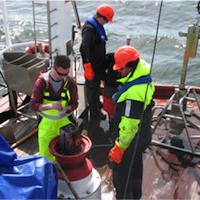
2012-12-19
This past September CHEMSEA concluded two sets of its characterisation cruises of munitions dumpsites in the Baltic Sea.
The Swedish Maritime Administration concluded the last of its multiple research surveys to the Gotland area, which it had begun in 2011, on board the M/V Baltica. These surveys used multibeam echosounders, sidescansonars, gradiometer and ROVs to detect object along the sea floor. In total, about 30,000 objects were detected in the Gotland area surveyed and classified according to their size and shape. An estimated 5–8000 of them are thought to be of the right size and shape to potentially correspond to dumped munitions.
Another cruise took place in September on board the R/V Oceania and focused on the munitions dumpsite areas of Gotland Deep and Gdansk Deep. The expedition was organised to carry out verification (using a side scan sonar) of objects previously detected by acoustic methods and confirmed with a magnetic anomaly detector. In addition, sediment and meiofauna samples were collected in the vicinity of the objects for the analysis of CWA and arsenic. Altogether, 18 stations were visited in these two dumpsites. About 6 objects with a high probability of being dumped munitions were found as well as one previously uncharted wreck.
The cruise included teams from the Polish Naval Academy, the Institute of Oceanology PAS, the Lithuanian Environmental Protection Agency and volunteers from the University of Gdańsk and Gdańsk University of Technology. In addition, French, German and Polish TV crews were also on board.
© CHEMSEA, IOPAN - wszelkie prawa zastrzeżone
Projekt i wykonanie - Virtual Services | Test zgodności W3C: HTML
Powered by: 